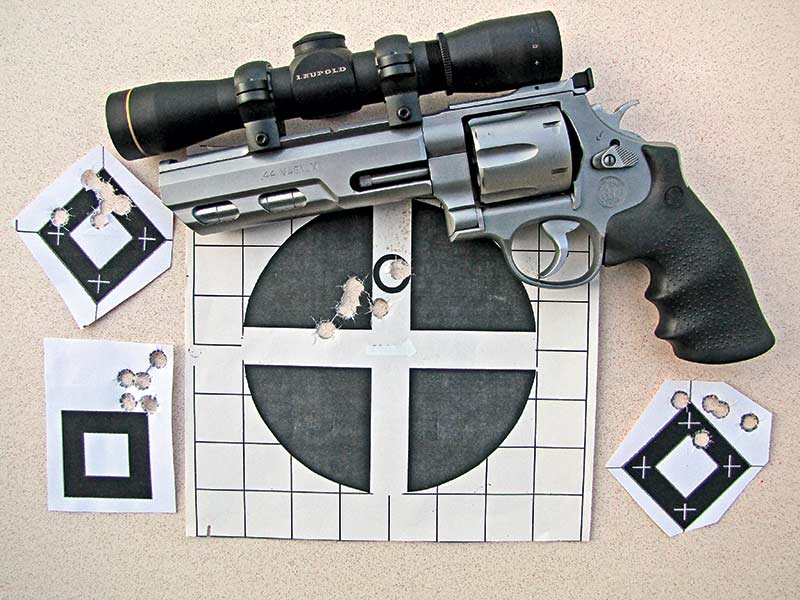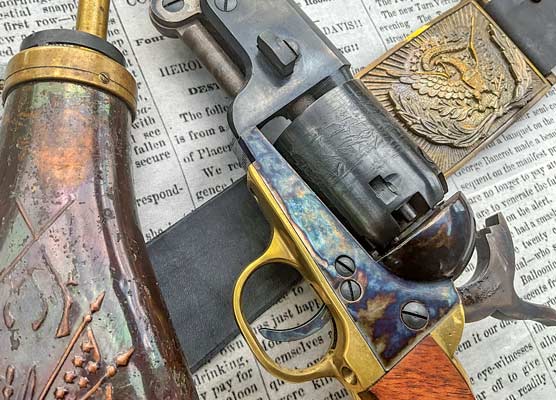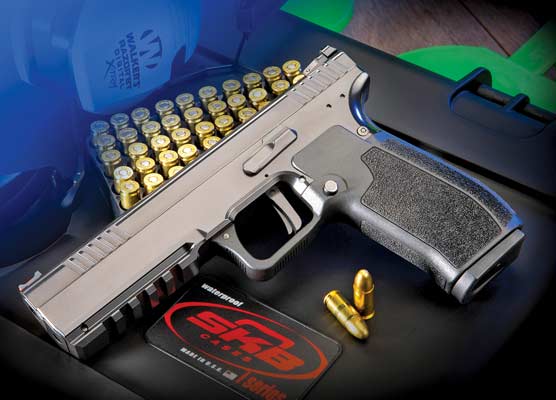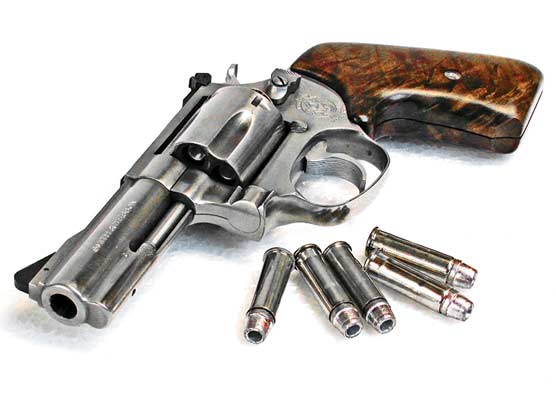S&W .44/.357 Competitor Models
Hunting & Competition
I’ll just say it: I’m a handgun hunter. I live it, breathe it, seek it out and engage in it whenever possible. When His Editorship assigned me to cover this duo, I balked. “But they’re target revolvers!” I muttered. But then I saw them, and immediately thought of a better use for them!
Through the years I’ve seen many handguns designed for competition. Most of these purpose-built guns were highly modified with embellishments specifically designed to enhance the intended activity. Seldom are these custom creations suitable for other applications, especially hunting. Be that as it may, these Performance Center revolvers from Smith & Wesson are fully capable of multitasking. While the Model 629 and 686 Competitors were manufactured for competition, they are great all-around revolvers, easily doing double-duty as hunting handguns.
Although they originate from their standard 686 and 629 designs, the Competitors certainly have been blessed with classy, custom touches. Both models are beefed-up versions of their counterparts. The glassbead finish is aesthetically pleasing and contrasts well with the Hogue black synthetic grip installed. Caliber designation is etched on one side of the barrel, “Competitor” on the other, without looking like a neon sign. The front sight consists of a black patridge dovetail, easily acquired in the notch of the black target-style rear sight, which is adjustable and removable (more on that later). Their frames and cylinders are stainless steel.
The major and most noticeable difference comes in the weighted 6″ barrels. These are, in actuality, target revolvers, and target shooters often like to custom-tune the “heft” of the barrel by adding or subtracting barrel weights. S&W enables that, but turned it into a design feature at the same time.
Five weighted inserts fit inside the massive underlug and can be removed to accommodate individual needs. By removing the Allen-head screw at the end of the underlug, shooters can remove one or all of the weighted disks if needed. You can see the weights from the cutout portion in the underlug; I think it’s all handsomely done.
All machine work and details of the barrel are streamlined. The Model 629 Competitor tipped the scales a little over 57 ounces, while the original Model 629 with the same barrel length weighs in at 45 ounces. The .357 Magnum version of the Model 686 Competitor weighs 53 ounces. That is nine ounces heavier than my standard 686.
Performance Center
The Performance Center’s tuned action was smooth and much what you would expect in a custom gun. Single-action trigger pull was crisp with zero creep, breaking around three pounds. The double-action mode was velvety. Located on the back side of the chrome trigger was a trigger stop. This is one feature I like shooting a revolver in single action, especially when I’m hunting. The serrated hammer was also finished in chrome. The overall fit and finish on both models were exactly what you would expect from a custom gun.
Both models featured integral mounting systems on their 6″ barrels. You can easily mount optics of your choice, be it scope or red dot. I wanted to use optics on both guns for accuracy testing and this feature made mounting a scope quick and easy. For this old guy, employing optics would be the only way I could determine their accuracy potential.
But Target Guns?
What were these revolvers actually designed for? Smith & Wesson’s Tony Miele told me the Model 686 Competitor was originally made for PPC competition, and they are still popular in Europe. I would only assume many of the PPC competitors here in the states are using semi-autos or perhaps their duty guns. PPC is a highly regimented target match requiring a high degree of accuracy from the hardware, and skill by the user. A PPC gun is a precision instrument and in the right hands can manage 1.5″ at 50 yards — or better!
The larger .44 Magnum could be used in bowling pin matches, steel plates and many other competitive games. Our very own Dave Anderson, who is kind of a competition guru, advised me they possibly could find use in ICOR: International Confederation of Revolver Enthusiasts, steel challenge or USPSA in the revolver division. Not being a serious competitor, I can see handgun hunters taking a liking to the larger .44 Magnum, especially.
The .357 Magnum version offers modest recoil (maybe good for a smaller-statured handgunner) but would certainly be up to the task of taking a whitetail deer at realistic ranges. It’s also a good revolver to “cut your teeth” on while learning handgun hunting.
In a nutshell, you don’t have to be in competition to enjoy either of these fine wheelguns. To get a better idea of what these Performance Center guns were capable of doing, I loaded the truck with a variety of ammunition and headed to the range.
Learning The Guns
On my first trip to the range, I shot from 25 yards with open sights exclusively. Factory ammo tested included .357 Magnum from Winchester and DoubleTap with both 125- and 158-gr. bullets. During the .44 Magnum session, ammo from Hornady, Federal, Cor-Bon, Black Hills, Buffalo Bore and Winchester were used, all with 240-gr. bullets. Groups were acceptable from all brands, but honestly, optics needed to be mounted on both guns to get a better idea of the accuracy potential. One of the first things I noticed was the nice trigger. The crisp, clean break without tugging all day made shooting both guns enjoyable. It’s difficult to shoot any handgun with a terrible trigger, one having creep or over-travel and doesn’t break without a struggle. These Performance Center triggers had been tuned perfectly.
Another notable aspect was the lack of muzzle rise compared to revolvers without weighted barrels. This makes getting subsequent shots off much faster and easier if needed. The additional weight of both guns also lessened felt recoil. I actually prefer a little heavier gun than most. Regardless, if I have to shoot offhand or get to take advantage of a rest of some sort, I feel the added weight helps me with more precise bullet placement.
Optics
With handgun hunting in the back of my mind, I mounted a quality Leupold 2X scope on the .44 Magnum using Burris Signature Zee Rings. I prefer Burris rings because they never leave a blemish on the scope tube. They also secure the optic firmly and I don’t worry about them coming loose. I had to remove the front sight which is easily drifted out of the ramp. The integral mounting system on the Competitor made mounting the scope quick and painless.
Two new red-dot sights arrived just in time from Meopta. This company is no stranger in the optics arena. Meopta has facilities in the US and Europe. They have been producing quality glass, in both military and sporting versions, for many years. Both of these red-dot sights were designed to aid quick target acquisition.
Thanks to a locking, lever-activated quick release mount, I slapped Meopta’s M-RAD reflex sight on the .357 Magnum. This sight comes in 3- or 5-MOA dot sizes. The sight conveniently incorporates eight levels of brightness adjustment for daylight shooting and another eight levels for nighttime activities. Shooters can fine-tune the dot intensity for a variety of conditions. The matte-black body is machined from aircraft-grade aluminum alloy and built to withstand the rigors of battlefield conditions. It’ll definitely survive your next handgun hunt!
With optics now in place and a fresh supply of ammo, a second trip to the range was in order. I shot the .44 Magnum with a variety of factory loads, including some .44 Specials, from 25 and 50 yards. While going through seven different brands of ammo, I was happy to see the Model 629 did not discriminate. All magnum loads consisted of 240-gr. bullets, except for Winchester’s new Razorback XT offering a 225-gr. beveled profile hollowpoint.
Groups were more than acceptable from most every manufacturer. Several 5-shot, 50-yard groups held much less than minute-of-deer. I ran a few .44 Specials through in double action “against” some rocks on the embankment. No steel plates, but allowed me to get an idea of what faster DA work might be like. I busted some rocks due to the slick action — even though this type of shooting is not my cup of tea. With the addition of the Leupold scope though, this would make a fine hunting revolver for deer, hogs or bear. I liked the feel of the Competitor. It handles recoil well, and balances nicely.
I will probably have a custom leather company like Diamond D Custom or 7X Leather make a holster for this scoped revolver. Both of these holster companies provide an across-the-chest rig ideal for the S&W Competitor.
The .357
My wife, Karen, and I shot the .357 Mag. with Winchester, Doubletap and Buffalo Bore ammo using 110-, 125-, 158- and 180-gr. bullets. After running the first cylinder on the 25-yard target she commented, “That’s a nice trigger!” I ran some .38 Special loads through in double action, and getting back on target for multiple shots was a snap. The M-RAD we were using had a 5-MOA dot size, which is fine for competition but for hunting purposes, I prefer the smaller 3-MOA dot. The 686 Competitor was just plain fun to shoot. The heavier frame is easier for me to shoot more accurately than my original model, and Karen also had fun shooting the .357 Mag. with Meopta’s reflex sight. The added weight and lower recoil really makes it a fun gun.
If you are searching for a first-class hunting revolver, the Competitors bear consideration. While these revolvers were made specifically for competition, they will make fine hunting handguns. Whether stalking whitetail in the woods or sneaking up to a big mean hog, the Model 629 Competitor will be a reliable friend. The .357 Magnum version is a perfect companion piece to the .44, and would allow training, new-shooter introduction to handgun hunting, and with lighter-bulleted loads, would make a fun varminter!









